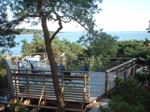Protection from wood pests
Wood is an extremely versatile resource which is chosen ahead of other raw materials because it is sustainable, as well as having many other assets.
As a natural product, it is subject to decomposition. Wood preservation measures of many different kinds contribute to maintaining the durability of this raw and building material. For wood used in outdoor structures, constructive and chemical wood protection are of importance. However, in many cases, constructive protection is not enough to guarantee the long-term stability of supporting and reinforcing elements in particular. In such cases, chemical protection is also required.
Chemical wood protection measures enable the application fields of timbers of low durability, such as beech, spruce or pine to be extended considerably and can also significantly increase the wood’s usability. Chemical wood protection measures make a substantial contribution to the conservation of resources and the sustainable use of local wood types, making it possible to do without the use of tropical timbers.
Constructive wood protection
The risk of timbers being attacked by wood-destroying or staining fungi depends on the moisture content of the wood, as these organisms require a minimum moisture level to be able to infest the wood. By applying constructive measures which contribute to reducing the moisture content, the risk of fungal infestation can be reduced.
Infestation by wood-destroying insects, however, is not prevented by these measures, as insects also attack dry wood.
Chemical wood protection
Modern, officially approved wood preservatives that have undergone extensive toxicological and eco-toxicological testing provide wood with lasting protection against wood-destroying fungi and insects, even in outdoor applications without or without ground contact. Such timbers for use in gardens and landscaping are usually treated using the vacuum pressure treatment process to guarantee deep protection for low durability local timbers.
In Germany, treatment companies work to the specifications in the wood preservation standard DIN 68800 part 3 "Preventive chemical wood protection" and in addition, many companies in Germany, and in Italy, also undergo voluntary quality monitoring in accordance with the RAL quality and testing standard "Impregnated wood construction elements” (RAL GZ 411).
There are of course other countries and regions in Europe with similar quality assurance systems, like Scandinavia (NTR), France (CTB-B+), Belgium (ATG), the Netherlands (Komo), Switzerland (Lignum) or Austria (KD-Holz).
